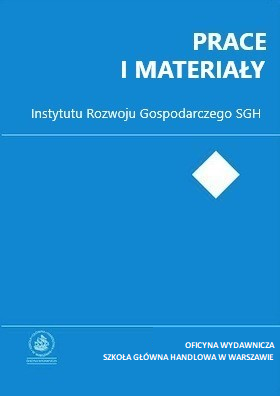Stochastic demands, fixed costs and time-varying Solow residual
Main Article Content
Abstract
In a general equilibrium model that contains the standard RBC model as a special case we provide a novel and yet very intuitive interpretation of the Solow residual. We argue in a simple framework with a micro-level uncertainty and fixed costs that movements in the measured value of the Solow residual can reflect endogenous evolution in the stock of knowledge on the status of individual market demands. We establish that transitory shocks can have persistent effects as they exacerbate informational imperfections. In addition, the Solow residual is shown to fluctuate even though the technological frontier is time invariant and factors are fully employed. Finally, we argue that movements in the measured value of the TFP can be caused by monetary disturbances.(original abstract)
Article Details
References
Acemoglu, D. (1993). Learning about others’ actions and the investment accelerator, The Economic Journal, 103 (417), 318-328.
Barlevy, G. (2002). Sullying effects of recessions, Review of Economic Studies, 69 (1), 65-95.
Bernanke, B., Gertler, M. (1989). Agency costs, net worth, and business fluctuations, American Economic Review, 79 (1), 14-31.
Bernanke, B., Gertler, M., Gilchrist, S. (1996). The financial accelerator and the flight to quality, The Review of Economics and Statistics, 78 (1), 1-15.
Bernanke, B., Gertler, M., Gilchrist, S. (1999). The financial accelerator in a quantitative business cycle framework, in Handbook of macroeconomics (vol. 1), J. Taylor, M. Woodford (eds), North-Holland, 1341-1393.
Blanchard, O.-J., Summers, L. (1986). Hysteresis and the European unemployment problem, NBER Macroeconomics Annual, 1, 15-78.
Blanchard, O.-J., Kiyotaki, N. (1987). Monopolistic competition and the effects of aggregate demand, American Economic Review, 77 (4), 647-77.
Blanchard, O.-J. (2008) The state of macro, MIT, mimeo.
Blanchard, O.-J. (1993). Consumption and the recession of 1990-1991, American Economic Review Papers and Proceedings, 83 (2), 270-274.
Brock, W. A., Evans, D. S. (1989). Small business economics, Small Business Economics, 1 (1), 7-20.
Caballero, R. J., Hammour, M. (1994). On cleansing effects of recessions, American Economic Review, 84 (5), 1350-1368.
Caballero, R. J., Hammour, M. (1998). Macroeconomics of specificity, Journal of Political Economy, 106 (4), 724-76.
Caplin, A., Leahy, J. (1994). Business as usual, market crashes, and wisdom after the fact, American Economic Review, 84 (3), 548-565.
Caplin, A., Leahy, J. (1993). Sectoral shocks, learning and aggregate fluctuations, Review of Economic Studies, 60 (4), 777-794.
Conlisk, J. (1989). An aggregate model of technical change, Quarterly Journal of Economics, 104 (4), 787-821.
Chari, V. V., P. Kehoe, P., McGrattan, E. (2007). Business cycle accounting, Econometrica, 75 (3), 781-836.
Fisher, F. M. (1969). The existence of aggregate production functions, Econometrica, 37 (4), 553-577.
Galí, J., Gertler, M., López-Salido, J. D. (2003). Markups, gaps, and the welfare costs of business fluctuations, Review of Economics and Statistics, 89 (1), 44-59.
Galí, J. (1994). Monopolistic competition, business cycles, and the composition of aggregate demand, Journal of Economic Theory, 63 (1), 73-96.
Gertler, M. (1982). Imperfect information and wage inertia in the business cycle, Journal of Political Economy, 91 (5), 967-987.
Greenwald, B., Stiglitz, J. E. (1993). Financial market imperfections and business cycles, Quarterly Journal of Economics, 108 (1), 77-114.
Fazzari, S, Hubbard, G., Petersen, B. C. (1988), Financing constraints and corporate investment, Brookings Papers on Economic Activity, 1, 141-195.
Friedman, M., Schwartz, A. J. (1963). A monetary history of the United States, 1867-1960. Princeton: Princeton University Press.
Jaimovich, N., Rebelo, S. (2006). Can news about the future drive the business cycle?, NBER Working Paper No. 12537.
Jovanovic, B. (2006). Asymmetric cycles, Review of Economic Studies, 73 (1), 145-162.
Kiyotaki, N. (1988). Multiple expectational equilibria under monopolistic competition, The Quarterly Journal of Economics, 103 (4), 695-713.
Kydland, F. E., Prescott, E. C. (1982). Time to build and aggregate fluctuations, Econometrica, 50 (6), 1345-1370.
Lagos, R. (2006). A model of TFP, Review of Economic Studies, 73 (4), 983-1007.
Lucas Jr., R. E. (1987). Models of business cycles, Oxford: Basil Blackwell.
Lorenzoni, G. (2009). A theory of demand shocks, American Economic Review, 99 (5), 2050-2084.
Mankiw, G. N., Reis, R. (2006). Sticky information in general equilibrium, NBER Working Paper No. 12605.
Matsuyama, K. (1999). Growth through cycles, Econometrica, 67 (2), 335-347.
Ouyang, M. (2009). The scarring effect of recessions, Journal of Monetary Economics, 56 (2), 184-199.
Prescott, E. C. (1998). Lawrence R. Klein lecture 1997 – Needed: A theory of total factor productivity, International Economic Review, 39 (3), 525-551.
Pries, M. J. (2004). Persistence of employment fluctuations: A model of recurring job loss, Review of Economic Studies, 71 (1), 193-215.
Rigobon, R. (1997). Learning by lending, M.I.T., Ph.D. thesis.
Shleifer, A. (1986). Implementation cycles, Journal of Political Economy, 94 (6), 1163-1190.
Stiglitz, J. E. (1999). Toward a general theory of wage and price rigidities and economic fluctuations, American Economic Review, 89 (2), 75-80.
Stiglitz, J. E., Weiss, A. (1992). Asymmetric information in credit markets and its implications for macroeconomics, Oxford Economic Papers, 44 (4), 694-724.
